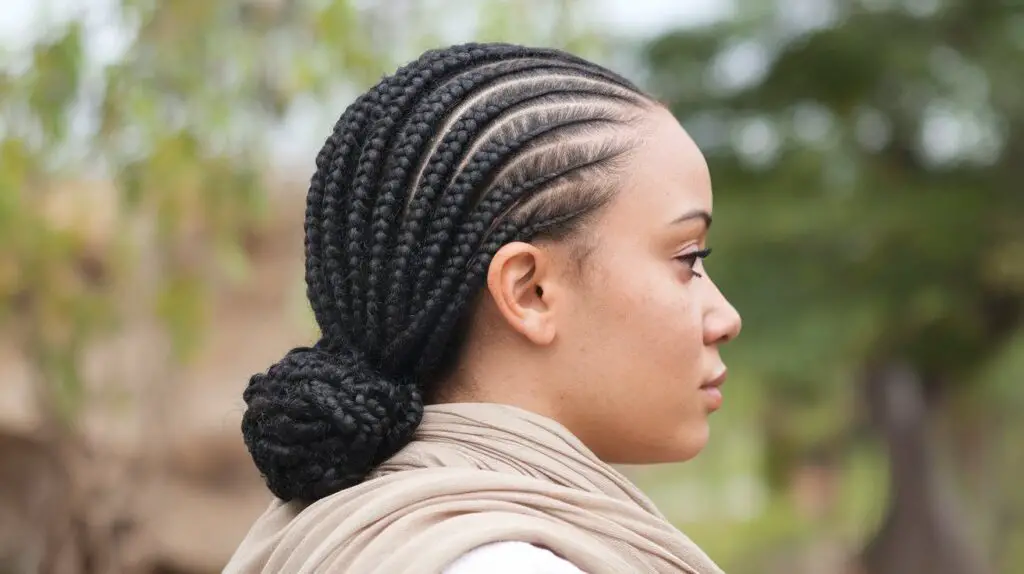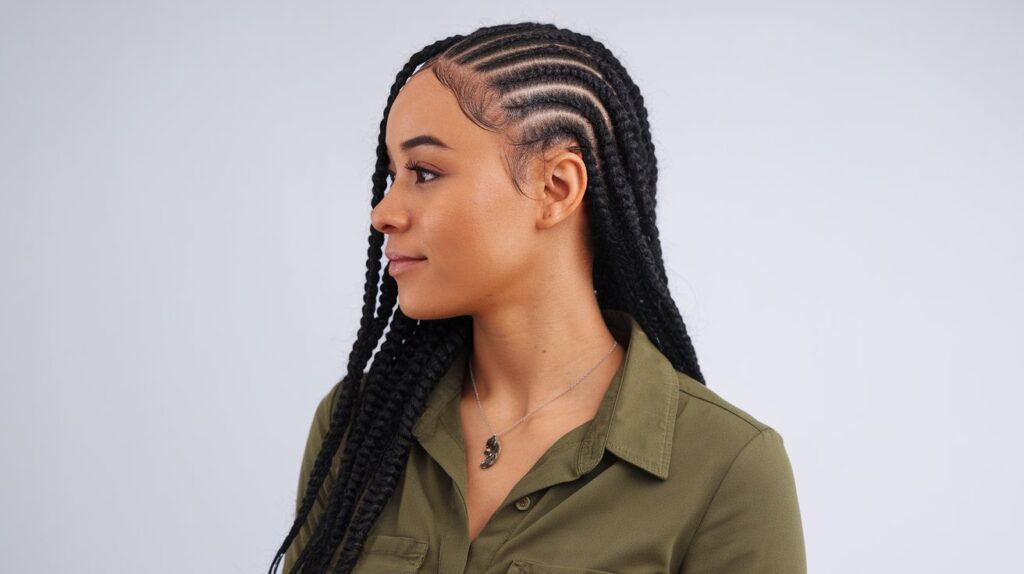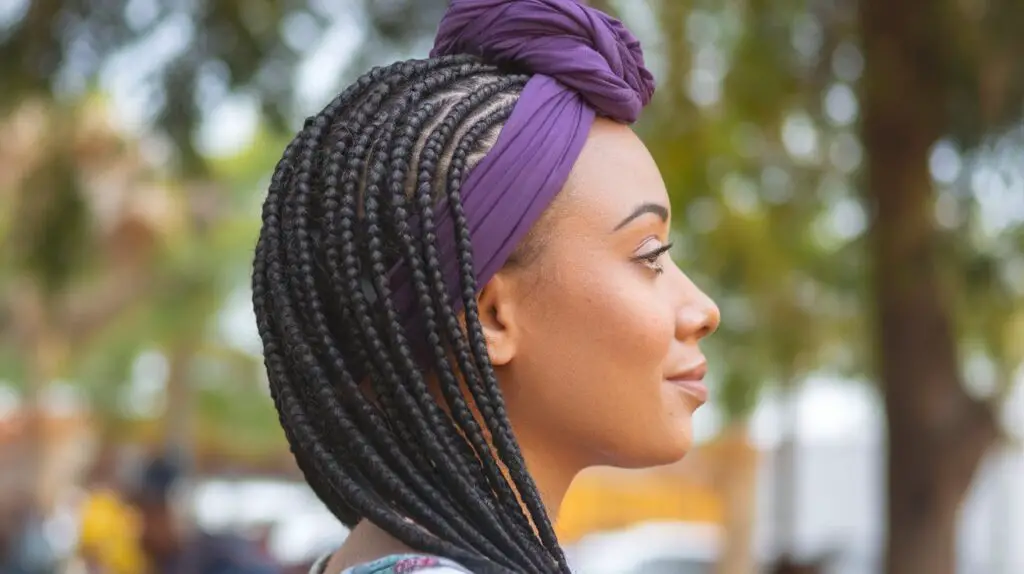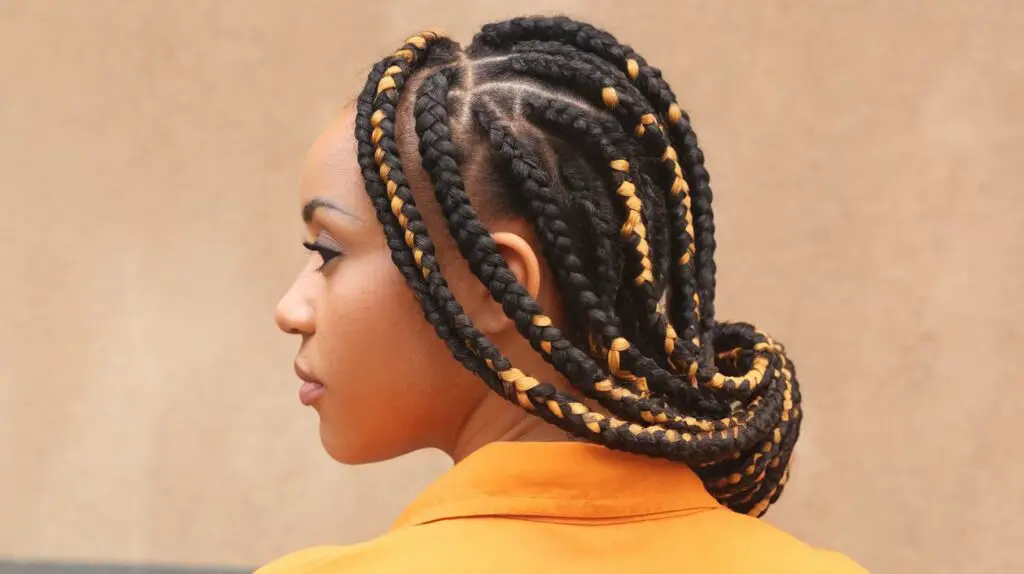Fulani braids are a stunning hairstyle that originated from the Fulani people of West Africa. These braids feature a unique pattern of cornrows braided close to the scalp, often adorned with beads or cowrie shells. The style has gained popularity worldwide for its beauty, versatility, and cultural significance.
Women love Fulani braids for several reasons. They offer a protective style that helps maintain hair health while looking elegant. The braids can be customized in various ways, allowing for personal expression. Additionally, they’re suitable for different hair types and lengths, making them accessible to many ladies.
We’ll explore here six simple Fulani braid styles perfect for beginners. We’ll discuss what makes these braids beginner-friendly, how to prepare your hair, and provide a step-by-step guide for creating basic Fulani braids. You’ll also learn about the longevity of this hairstyle and how to maintain it. Keep reading to discover how you can achieve this beautiful look at home.
What Makes Fulani Braids Beginner-Friendly?

Fulani braids have gained popularity among beginners for good reasons. These beautiful African-inspired hairstyles offer a perfect blend of simplicity and elegance, making them an excellent choice for those new to braiding. Let’s explore why this particular style is so beginner-friendly.
Minimal sectioning required
One of the most daunting aspects of braiding for novices is the intricate sectioning often required. Fulani braids, however, simplify this process. You don’t need to create numerous tiny sections across your entire head. Instead, this style typically involves larger, more manageable sections, reducing the time and effort needed to prepare your hair.
Why does this matter? Well, fewer sections mean less chance of making mistakes or becoming overwhelmed. It’s like solving a puzzle with fewer pieces – much more manageable for those just starting out.
Basic braiding techniques
Are you worried about mastering complex braiding methods? With Fulani braids, you can put those concerns to rest. This style primarily uses simple cornrow techniques, which are relatively easy to learn and practice.
Here’s what makes the braiding process more approachable:
- Straightforward pattern: The braids follow a clear, repeatable pattern
- Visible results: You can see your progress as you go along
- Forgiving nature: Small mistakes are often less noticeable in the overall style
Versatile styling options
Despite their simplicity, Fulani braids offer a wide range of styling possibilities. You can customize the look to suit your preferences without needing advanced skills. Want to add some flair? Try incorporating beads or cowrie shells into your braids. Prefer a more understated look? Keep it simple with clean, unadorned braids.
This versatility allows beginners to experiment and find a style that works best for them, all while building confidence in their braiding abilities.
Manageable size and length
The size and length of Fulani braids contribute significantly to their beginner-friendly nature. Unlike some styles that require ultra-thin or extremely long braids, Fulani braids are typically medium-sized and can be adjusted to your desired length.
This manageability is crucial for several reasons:
- Easier to handle during the braiding process
- Less strain on your arms and hands
- Quicker to complete, reducing fatigue
Forgiving pattern for novices
Perhaps one of the most reassuring aspects of Fulani braids for beginners is their forgiving nature. The pattern is not as strict as some other braided styles, allowing for small imperfections without ruining the overall look.
This forgiveness extends to the braiding technique as well. If you’re still perfecting your tension or struggling with consistent braid sizes, don’t worry. The beauty of Fulani braids lies in their slightly rustic, handcrafted appearance. Small variations can add character to your style rather than detract from it.
Moreover, the pattern’s flexibility means you can adjust as you go. If one section doesn’t turn out quite right, you can often modify the next to balance it out. This adaptability reduces stress and allows you to learn and improve with each braid you create.
In the world of hair braiding, Fulani braids stand out as a fantastic starting point for beginners. They offer a perfect balance of simplicity and style, allowing you to create a stunning look while developing your skills. Whether you’re looking for a protective style or simply want to try something new, these braids provide an accessible entry point into the art of African-inspired hairstyling.
How to Prepare Your Hair for Fulani Braids

Preparing your hair for Fulani braids is a crucial step that can make or break your final look. This African-inspired hairstyle requires some groundwork to achieve the best results. Let’s explore the essential steps to get your hair ready for this beautiful style.
Washing and conditioning
Start with clean, fresh hair. Use a clarifying shampoo to remove any buildup from previous products. This step is vital as it creates a clean canvas for your braids. After shampooing, apply a deep conditioner to nourish your hair.
Why is conditioning so important? Well-conditioned hair is more manageable and less prone to breakage during the braiding process. Leave the conditioner on for about 15-20 minutes, then rinse thoroughly with cool water to seal the hair cuticles.
Detangling thoroughly
Now that your hair is clean and conditioned, it’s time to tackle those knots. Detangling is a critical step that many people rush through, but taking your time here can save you a lot of trouble later.
Start at the ends of your hair and work your way up to the roots. Use a wide-tooth comb or a detangling brush to gently remove any knots. If you encounter a particularly stubborn tangle, don’t force it. Instead, apply a bit more conditioner to that section and try again.
Here are some tips for effective detangling:
- Work in sections
- Use your fingers first to remove larger knots
- Be patient and gentle to avoid breakage
- Consider using a detangling spray for extra slip
Moisturizing the scalp
A healthy scalp is the foundation for beautiful braids. After detangling, focus on moisturizing your scalp. This step is often overlooked, but it’s crucial for maintaining scalp health while your hair is in braids.
Apply a light, non-greasy oil or moisturizer to your scalp. Jojoba oil, almond oil, or a specially formulated braid spray can work wonders. Gently massage the product into your scalp to stimulate blood flow and distribute it evenly.
Sectioning the hair
With your hair clean, detangled, and moisturized, it’s time to section it. This step might seem tedious, but proper sectioning can make the braiding process much smoother.
How should you section your hair? The exact pattern will depend on your desired Fulani braid style, but generally, you’ll want to create clean, straight parts. Use hair clips or small elastics to keep each section separate.
Remember, the key to neat Fulani braids is consistency in your sections. Take your time and use a mirror to check that your parts are straight and even.
Gathering necessary tools
Before you start braiding, make sure you have all the tools you need within reach. Nothing’s more frustrating than having to stop mid-braid to search for a missing item.
What should you gather? Here’s a quick checklist:
- Rat-tail comb for precise parting
- Hair clips or elastics for sectioning
- Edge control or gel for a polished look
- Braiding hair (if using extensions)
- Small rubber bands to secure the ends
- Scissors for trimming excess hair
- A spray bottle with water to keep hair damp
Having these tools ready will streamline your braiding process and help you achieve a more professional-looking result.
By following these preparation steps, you’re setting yourself up for success with your Fulani braids. Good preparation can make the difference between a so-so braid job and a stunning, long-lasting style. Take your time with each step, and don’t rush the process. Your hair will thank you, and your braids will look all the better for it.
Remember, the key to great Fulani braids isn’t just in the braiding technique, but in how well you prepare your hair. With clean, well-moisturized, and properly sectioned hair, you’re ready to create a beautiful Fulani braid style that will turn heads and keep your hair protected.
What Are the 6 Simple Fulani Braid Styles for Beginners?

Fulani braids offer a world of possibilities, even for those just starting their hair journey. These six styles are perfect for beginners, combining simplicity with elegance. Let’s explore each one and see how you can create these stunning looks.
Classic center-parted Fulani braids
The quintessential Fulani braid style begins with a clean center part. This look is timeless and suits most face shapes. To achieve this style, part your hair down the middle from forehead to nape. Then, create cornrows on each side, braiding towards the back. The result? A symmetrical, polished appearance that’s both chic and practical.
Why choose this style? It’s straightforward to create and maintains a neat look for longer. Plus, the center part adds a touch of sophistication to your overall appearance.
Side-swept Fulani braids
Want to add a bit of drama to your look? Side-swept Fulani braids might be just what you’re after. This style involves parting your hair to one side and braiding the majority of your hair in that direction. The result is an asymmetrical look that’s both edgy and elegant.
How do you decide which side to sweep to? Try both and see which you prefer. Some women find that sweeping to their “good side” (the side they prefer in photos) works best.
Half-up, half-down Fulani braids
This versatile style combines the best of both worlds. You’ll braid the top section of your hair, typically from the crown to the forehead, while leaving the back loose. It’s a great option for those who want to keep some length and movement in their style.
Here’s a quick guide to achieve this look:
- Part your hair horizontally from ear to ear
- Braid the top section in the Fulani style
- Leave the bottom section loose or lightly styled
- Secure the braided section with small elastics
Fulani braids with beads
Adding beads to your Fulani braids is a fantastic way to personalize your style. This look pays homage to the traditional Fulani style while allowing for modern interpretation. You can add beads to the ends of your braids, or incorporate them throughout for a more intricate look.
When choosing beads, consider your color palette. Do you want them to blend in or stand out? Wooden beads offer a natural look, while metallic ones add shine. Remember, less is often more when you’re starting out.
Mini Fulani braids
If you’re looking for a more detailed look, mini Fulani braids might be your style. This variation uses smaller sections of hair, resulting in more braids overall. While it takes longer to create, the result is a intricate, textured look that can last for weeks with proper care.
A word of caution: mini braids require more time and patience. If you’re new to braiding, you might want to practice with larger sections before attempting this style.
Fulani braids with a bun
Combining Fulani braids with a bun creates a stylish updo that’s perfect for various occasions. This style involves braiding the front and sides of your hair in the Fulani pattern, then gathering the back into a bun. It’s a great way to keep your hair off your neck while maintaining the beautiful Fulani aesthetic.
To create this style, follow these steps:
- Braid the front and sides in the Fulani pattern
- Gather the unbraided hair at the back
- Twist or braid this section
- Wrap it into a bun and secure with pins
Each of these styles offers a unique take on the classic Fulani braid. As you experiment with these looks, you’ll discover which ones suit you best. Don’t be afraid to mix and match elements from different styles to create your own signature look.
Remember, practice makes perfect. If your first attempt doesn’t turn out exactly as you hoped, don’t get discouraged. With each try, you’ll improve your technique and develop a better understanding of what works for your hair.
These six styles are just the beginning of your Fulani braid journey. As you become more comfortable with the technique, you’ll find countless ways to customize and adapt these looks to suit your personal style. Happy braiding!
How to Create Basic Fulani Braids: Step-by-Step Guide

Creating basic Fulani braids might seem challenging at first, but with practice, you’ll find it’s quite achievable. Let’s break down the process into manageable steps.
Parting the hair
The foundation of any good Fulani braid style is proper parting. Start with clean, detangled hair. Use a rat-tail comb to create a center part from your forehead to the nape of your neck. This will be your main guide.
Next, create smaller sections on each side of this center part. The number of sections depends on how many braids you want. For beginners, it’s best to start with fewer, larger sections. You can always increase the number as you become more skilled.
Pro tip: Clip each section separately to keep them organized and prevent tangling.
Starting the cornrows
Now that your hair is parted, it’s time to begin the cornrows. These are the foundation of Fulani braids. Start at the front of your head, near your hairline.
Take a small section of hair and divide it into three equal parts. Begin a regular three-strand braid, but instead of braiding down, braid backwards towards your scalp. As you braid, incorporate small amounts of loose hair from the section you’re working on.
The key to neat cornrows is consistent tension. Keep your fingers close to the scalp and maintain even pressure as you braid. This helps create a smooth, tight braid that will last longer.
Adding hair extensions
Many Fulani braid styles incorporate hair extensions for added length and fullness. If you’re using extensions, this is where they come in.
How do you add extensions to your braids? Here’s a quick guide:
- Separate a small piece of the extension hair
- Place it alongside one of the three sections of your natural hair
- Braid it in as if it were part of your own hair
- Continue adding small pieces of extension hair as you braid
Remember, less is more when you’re starting out. It’s easier to work with smaller amounts of extension hair and add more if needed.
Securing the braids
As you reach the end of each braid, you’ll need to secure it. There are a few ways to do this:
- Use small elastic bands to tie off the ends
- Dip the ends in hot water to seal them (if using synthetic hair)
- Wrap the ends with thread for a traditional look
Choose the method that works best for your style and hair type. If you’re unsure, start with elastic bands – they’re easy to remove if you change your mind.
Styling the edges
The final touch to your Fulani braids is styling the edges. This step can elevate your look from good to great. Use an edge control product and a small brush or toothbrush to smooth down any baby hairs around your hairline.
You can create simple swoops or more intricate designs, depending on your preference and skill level. Start with basic shapes and experiment as you become more comfortable.
A word of caution: Be gentle with your edges. Excessive manipulation can lead to breakage over time.
Creating Fulani braids takes time and patience, especially when you’re just starting out. Don’t get discouraged if your first attempt isn’t perfect. Each time you braid, you’ll improve your technique and speed.
One common question is: “How long does it take to create Fulani braids?” The answer varies depending on your skill level, the complexity of the style, and whether you’re using extensions. For beginners, it might take several hours. As you practice, you’ll become faster.
Another tip: Take breaks if you need to. Braiding can be tiring on your arms and hands. It’s better to pause and come back refreshed than to rush and make mistakes.
Remember, the beauty of Fulani braids lies in their slightly imperfect, handcrafted look. So don’t stress if your braids aren’t exactly identical – that’s part of their charm.
With these steps, you’re well on your way to creating beautiful Fulani braids. Keep practicing, and soon you’ll be able to create this stunning style with ease.
How Long Do Fulani Braids Last?
Fulani braids are a beautiful and practical hairstyle, but how long can you expect them to last? Let’s explore the lifespan of this popular style and how you can make the most of it.
Average duration of the style
Typically, Fulani braids can last anywhere from 2 to 6 weeks. This wide range might seem surprising, but it’s due to various factors that influence the longevity of the style. Some women find their braids looking fresh for a full month and a half, while others might need to refresh their style after just a couple of weeks.
Why such a difference? Well, it’s all about your hair type, lifestyle, and how well you care for your braids. Let’s dig deeper into these factors.
Factors affecting longevity
Your hair type plays a significant role in how long your Fulani braids will last. Coarser hair types tend to hold braids longer, while finer hair might slip out more easily. But that’s not all – several other elements come into play:
- Hair texture and growth rate
- Scalp condition and oil production
- Daily activities and exercise habits
- Sleeping habits and nighttime hair care
- Environmental factors like humidity and sun exposure
Active lifestyles with lots of sweating or swimming might shorten the lifespan of your braids. Similarly, if you have a naturally oily scalp, you might find your braids loosening faster.
Proper maintenance tips
Now, how can you keep your Fulani braids looking fresh for as long as possible? The key is proper maintenance. Here are some tips to help you extend the life of your braids:
- Keep your scalp clean: Use a diluted shampoo or witch hazel on a cotton swab to clean your scalp without disturbing the braids.
- Moisturize regularly: Apply a light oil or braid spray to keep your hair and scalp hydrated.
- Protect while sleeping: Use a silk or satin scarf or pillowcase to reduce friction and frizz.
- Avoid excessive touching: The more you play with your braids, the faster they’ll loosen.
- Be gentle during washing: If you need to wash your hair, do so gently and avoid rubbing the braids vigorously.
By following these tips, you can potentially add an extra week or two to the life of your Fulani braids.
When to remove the braids
Even with the best care, there will come a time when you need to remove your Fulani braids. But how do you know when that time has come? Here are some signs to watch for:
- Excessive frizz that can’t be tamed
- Visible new growth at the roots (more than 1/2 inch)
- Braids feeling heavy or causing scalp discomfort
- Unraveling or loosening of multiple braids
If you notice any of these signs, it’s probably time to say goodbye to your Fulani braids. Keeping them in for too long can lead to tangling, matting, and potentially even damage to your natural hair.
Transitioning to a new style
So, you’ve decided it’s time to remove your Fulani braids. What’s next? Transitioning to a new style can be an exciting opportunity to change up your look. Here are some steps to follow:
- Gently unravel each braid, starting from the bottom.
- Remove any extensions or added hair.
- Detangle your hair thoroughly using a wide-tooth comb.
- Deep condition your hair to restore moisture.
- Give your hair a break before styling again, if possible.
After removing your braids, you might want to rock your natural texture for a while. Or perhaps you’re ready to try a different protective style. Whatever you choose, make sure to give your hair and scalp some TLC before your next styling adventure.
Remember, the goal is to keep your hair healthy while enjoying versatile styles. Fulani braids are a fantastic option, but they’re just one of many beautiful hairstyles you can explore. By understanding how long they last and how to care for them, you can make the most of this stunning look while keeping your hair in top condition.
Embracing Your Fulani Braid Journey
Fulani braids offer a beautiful blend of tradition and modern style, perfect for women looking to express their creativity through their hair. From the initial preparation to the final removal, each step in the Fulani braid process is an opportunity to care for your hair and showcase your personal flair. Whether you opt for classic center-parted braids or experiment with beads and buns, these versatile styles can adapt to your unique preferences and lifestyle.
As you explore the world of Fulani braids, remember that practice and patience are your best friends. Don’t be discouraged if your first attempt isn’t perfect – each time you braid, you’ll improve your technique and discover new ways to make the style your own. With proper care and maintenance, your Fulani braids can be a stunning, long-lasting look that turns heads and keeps your hair protected. So go ahead, give Fulani braids a try, and enjoy the journey of discovering a new favorite hairstyle.
Frequently Asked Questions
Q: What are Fulani braids?
A: Fulani braids are a traditional African hairstyle featuring cornrows braided close to the scalp, often adorned with beads or cowrie shells.
Q: How long do Fulani braids typically last?
A: Fulani braids can last anywhere from 2 to 6 weeks, depending on various factors such as hair type, maintenance, and lifestyle.
Q: Are Fulani braids suitable for beginners?
A: Yes, Fulani braids can be suitable for beginners due to their relatively simple braiding technique and forgiving pattern.
Q: What’s the best way to prepare hair for Fulani braids?
A: To prepare for Fulani braids, wash and condition your hair, detangle thoroughly, moisturize your scalp, and section your hair properly.
Q: Can I add hair extensions to my Fulani braids?
A: Yes, you can add hair extensions to Fulani braids for added length and fullness.
Q: How often should I wash my hair with Fulani braids?
A: It’s best to avoid frequent washing. Instead, clean your scalp with a diluted shampoo or witch hazel on a cotton swab as needed.
Q: What are some signs that it’s time to remove Fulani braids?
A: Signs to remove Fulani braids include excessive frizz, visible new growth (more than 1/2 inch), scalp discomfort, and multiple braids unraveling.
Q: How can I make my Fulani braids last longer?
A: To extend the life of your Fulani braids, keep your scalp clean, moisturize regularly, protect your hair while sleeping, and avoid excessive touching.
Q: What should I do after removing my Fulani braids?
A: After removing Fulani braids, gently detangle your hair, deep condition it, and consider giving your hair a break before styling again.

